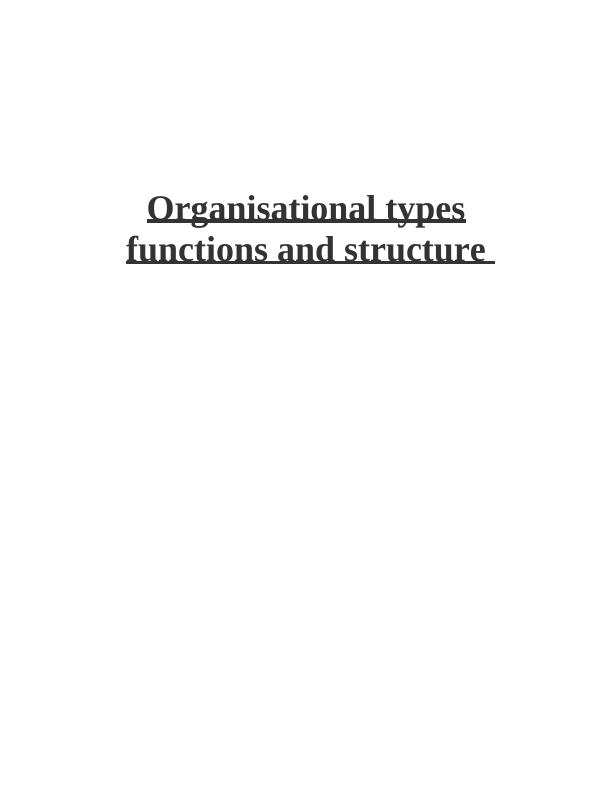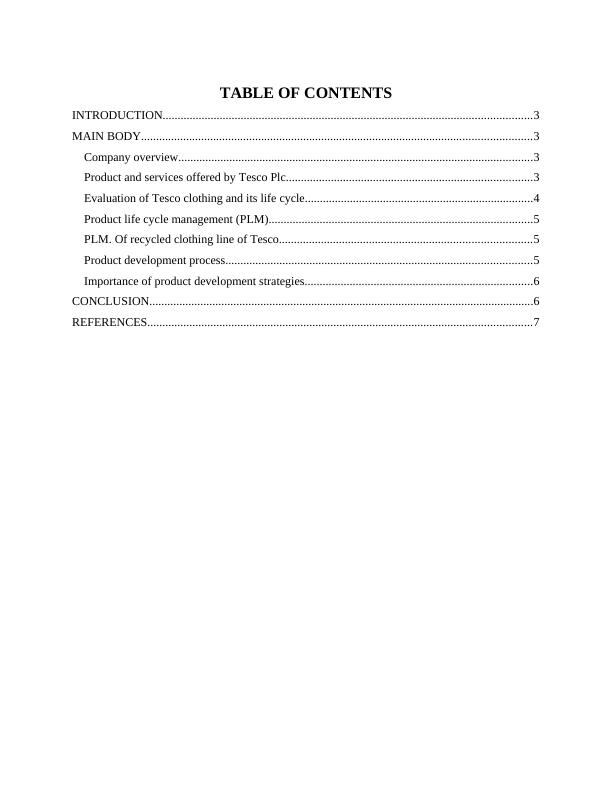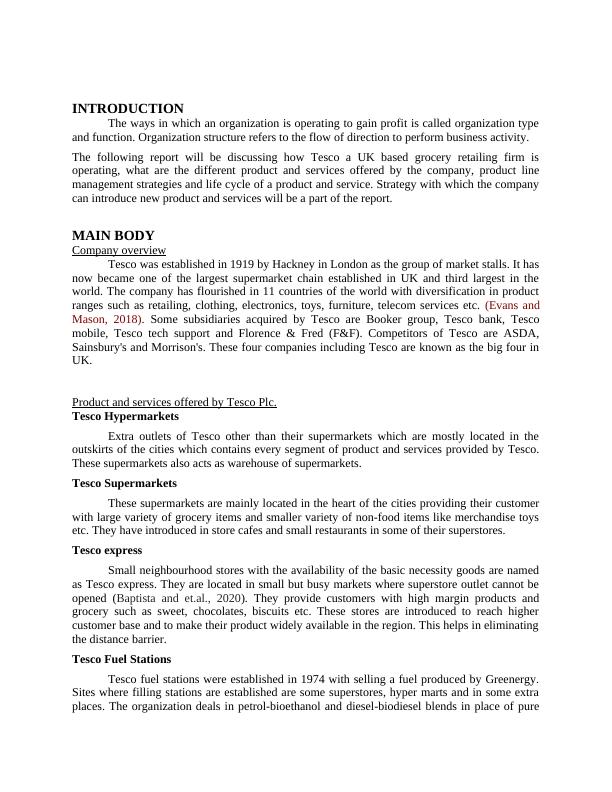Organisational Types Functions and Structures Part 1 Business Environmental Analysis Part 2
Added on 2023-06-10
20 Pages3281 Words461 Views
Organisational types
functions and structure
functions and structure

TABLE OF CONTENTS
INTRODUCTION...........................................................................................................................3
MAIN BODY..................................................................................................................................3
Company overview......................................................................................................................3
Product and services offered by Tesco Plc..................................................................................3
Evaluation of Tesco clothing and its life cycle............................................................................4
Product life cycle management (PLM)........................................................................................5
PLM. Of recycled clothing line of Tesco....................................................................................5
Product development process......................................................................................................5
Importance of product development strategies............................................................................6
CONCLUSION................................................................................................................................6
REFERENCES................................................................................................................................7
INTRODUCTION...........................................................................................................................3
MAIN BODY..................................................................................................................................3
Company overview......................................................................................................................3
Product and services offered by Tesco Plc..................................................................................3
Evaluation of Tesco clothing and its life cycle............................................................................4
Product life cycle management (PLM)........................................................................................5
PLM. Of recycled clothing line of Tesco....................................................................................5
Product development process......................................................................................................5
Importance of product development strategies............................................................................6
CONCLUSION................................................................................................................................6
REFERENCES................................................................................................................................7

INTRODUCTION
The ways in which an organization is operating to gain profit is called organization type
and function. Organization structure refers to the flow of direction to perform business activity.
The following report will be discussing how Tesco a UK based grocery retailing firm is
operating, what are the different product and services offered by the company, product line
management strategies and life cycle of a product and service. Strategy with which the company
can introduce new product and services will be a part of the report.
MAIN BODY
Company overview
Tesco was established in 1919 by Hackney in London as the group of market stalls. It has
now became one of the largest supermarket chain established in UK and third largest in the
world. The company has flourished in 11 countries of the world with diversification in product
ranges such as retailing, clothing, electronics, toys, furniture, telecom services etc. (Evans and
Mason, 2018). Some subsidiaries acquired by Tesco are Booker group, Tesco bank, Tesco
mobile, Tesco tech support and Florence & Fred (F&F). Competitors of Tesco are ASDA,
Sainsbury's and Morrison's. These four companies including Tesco are known as the big four in
UK.
Product and services offered by Tesco Plc.
Tesco Hypermarkets
Extra outlets of Tesco other than their supermarkets which are mostly located in the
outskirts of the cities which contains every segment of product and services provided by Tesco.
These supermarkets also acts as warehouse of supermarkets.
Tesco Supermarkets
These supermarkets are mainly located in the heart of the cities providing their customer
with large variety of grocery items and smaller variety of non-food items like merchandise toys
etc. They have introduced in store cafes and small restaurants in some of their superstores.
Tesco express
Small neighbourhood stores with the availability of the basic necessity goods are named
as Tesco express. They are located in small but busy markets where superstore outlet cannot be
opened (Baptista and et.al., 2020). They provide customers with high margin products and
grocery such as sweet, chocolates, biscuits etc. These stores are introduced to reach higher
customer base and to make their product widely available in the region. This helps in eliminating
the distance barrier.
Tesco Fuel Stations
Tesco fuel stations were established in 1974 with selling a fuel produced by Greenergy.
Sites where filling stations are established are some superstores, hyper marts and in some extra
places. The organization deals in petrol-bioethanol and diesel-biodiesel blends in place of pure
The ways in which an organization is operating to gain profit is called organization type
and function. Organization structure refers to the flow of direction to perform business activity.
The following report will be discussing how Tesco a UK based grocery retailing firm is
operating, what are the different product and services offered by the company, product line
management strategies and life cycle of a product and service. Strategy with which the company
can introduce new product and services will be a part of the report.
MAIN BODY
Company overview
Tesco was established in 1919 by Hackney in London as the group of market stalls. It has
now became one of the largest supermarket chain established in UK and third largest in the
world. The company has flourished in 11 countries of the world with diversification in product
ranges such as retailing, clothing, electronics, toys, furniture, telecom services etc. (Evans and
Mason, 2018). Some subsidiaries acquired by Tesco are Booker group, Tesco bank, Tesco
mobile, Tesco tech support and Florence & Fred (F&F). Competitors of Tesco are ASDA,
Sainsbury's and Morrison's. These four companies including Tesco are known as the big four in
UK.
Product and services offered by Tesco Plc.
Tesco Hypermarkets
Extra outlets of Tesco other than their supermarkets which are mostly located in the
outskirts of the cities which contains every segment of product and services provided by Tesco.
These supermarkets also acts as warehouse of supermarkets.
Tesco Supermarkets
These supermarkets are mainly located in the heart of the cities providing their customer
with large variety of grocery items and smaller variety of non-food items like merchandise toys
etc. They have introduced in store cafes and small restaurants in some of their superstores.
Tesco express
Small neighbourhood stores with the availability of the basic necessity goods are named
as Tesco express. They are located in small but busy markets where superstore outlet cannot be
opened (Baptista and et.al., 2020). They provide customers with high margin products and
grocery such as sweet, chocolates, biscuits etc. These stores are introduced to reach higher
customer base and to make their product widely available in the region. This helps in eliminating
the distance barrier.
Tesco Fuel Stations
Tesco fuel stations were established in 1974 with selling a fuel produced by Greenergy.
Sites where filling stations are established are some superstores, hyper marts and in some extra
places. The organization deals in petrol-bioethanol and diesel-biodiesel blends in place of pure

petroleum and diesel. Recently they are providing their customers with 100% biodiesel
developed by Greenergy, at their filling stations.
In late 90's, the company formed alliance with Esso to take filling station on lease for
running its express shop under petrol pumps and Esso operated filling station under superstores
of Tesco. There are more than 200 merged Tesco/ Esso sites in UK.
Online mart
Tesco is mainly a supermarket chain that provides their customer with grocery and other
household products. They launched an online portal, Tesco.com for their customers to purchase
product from the comfort of their homes. Tesco introduced this facility in 1984 and since then
they were the sole supermarket retailer who provided this service to their customer till 2006.
They established number of dark store to provide online services to their customer.
Evaluation of Tesco clothing and its life cycle
Tesco Home N Wear which was led by Leslie Porter, was a non-food division which
operated in the cloth retailing sector through stand-alone shops. With the matter of time Tesco
started stocking these merchandise in its hypermarkets and closed all the stand-alone shops.
Life cycle of clothing product line
Introduction stage
The time when the product is being launched is called introduction stage. Tesco
introduced recycled merchandise in the market but during this period they were not able to make
high sales due to the lack of awareness among their customers. Instead of using powerful
marketing methods the company only did advertising and branding thinking that their reputation
in the world is enough to sell their product.
Growth Stage
In this stage, the company got the recognition in the market but still there was slow
growth in the sales. Company wanted to penetrate the market by providing a large variety of
clothing styles but it led to over exploitation (Grainger-Brown and Malekpour, 2019). In the
period of time they increased their sales with effective marketing and established a good position
in the sector.
Maturity stage
The maturity stage is the time when the product has reached its highest scale in the sales
and profit graph. Although it was growing gradually but it was at the peak in its life cycle. The
company benefited during this period by gaining more customer towards their product. This
resulted in less marketing investment and higher profits. As a result the company worked on its
price policies and provided the customers with high quality clothes in lower prices.
Decline stage
As the company reached higher awareness in the market the customers started loosing
interest in the styles and varieties provided by the brand. The company was not able to meet the
styles and design that were in the trend (Al-Sarawi and et.al., 2020). They were not able to keep
developed by Greenergy, at their filling stations.
In late 90's, the company formed alliance with Esso to take filling station on lease for
running its express shop under petrol pumps and Esso operated filling station under superstores
of Tesco. There are more than 200 merged Tesco/ Esso sites in UK.
Online mart
Tesco is mainly a supermarket chain that provides their customer with grocery and other
household products. They launched an online portal, Tesco.com for their customers to purchase
product from the comfort of their homes. Tesco introduced this facility in 1984 and since then
they were the sole supermarket retailer who provided this service to their customer till 2006.
They established number of dark store to provide online services to their customer.
Evaluation of Tesco clothing and its life cycle
Tesco Home N Wear which was led by Leslie Porter, was a non-food division which
operated in the cloth retailing sector through stand-alone shops. With the matter of time Tesco
started stocking these merchandise in its hypermarkets and closed all the stand-alone shops.
Life cycle of clothing product line
Introduction stage
The time when the product is being launched is called introduction stage. Tesco
introduced recycled merchandise in the market but during this period they were not able to make
high sales due to the lack of awareness among their customers. Instead of using powerful
marketing methods the company only did advertising and branding thinking that their reputation
in the world is enough to sell their product.
Growth Stage
In this stage, the company got the recognition in the market but still there was slow
growth in the sales. Company wanted to penetrate the market by providing a large variety of
clothing styles but it led to over exploitation (Grainger-Brown and Malekpour, 2019). In the
period of time they increased their sales with effective marketing and established a good position
in the sector.
Maturity stage
The maturity stage is the time when the product has reached its highest scale in the sales
and profit graph. Although it was growing gradually but it was at the peak in its life cycle. The
company benefited during this period by gaining more customer towards their product. This
resulted in less marketing investment and higher profits. As a result the company worked on its
price policies and provided the customers with high quality clothes in lower prices.
Decline stage
As the company reached higher awareness in the market the customers started loosing
interest in the styles and varieties provided by the brand. The company was not able to meet the
styles and design that were in the trend (Al-Sarawi and et.al., 2020). They were not able to keep

End of preview
Want to access all the pages? Upload your documents or become a member.
Related Documents
Analyzing Competitive Environment and Logistical Operations of TESCOlg...
|11
|3780
|1
Tesco Plclg...
|11
|3517
|31
Implementation of Various Strategies in Tescolg...
|10
|2746
|52
Business Strategy | Tesco Plclg...
|15
|4724
|163
Principles and Practice of Marketing INTRODUCTIONlg...
|18
|4732
|243
Leadership Styles Assignment - UK RETAILlg...
|9
|2594
|323
